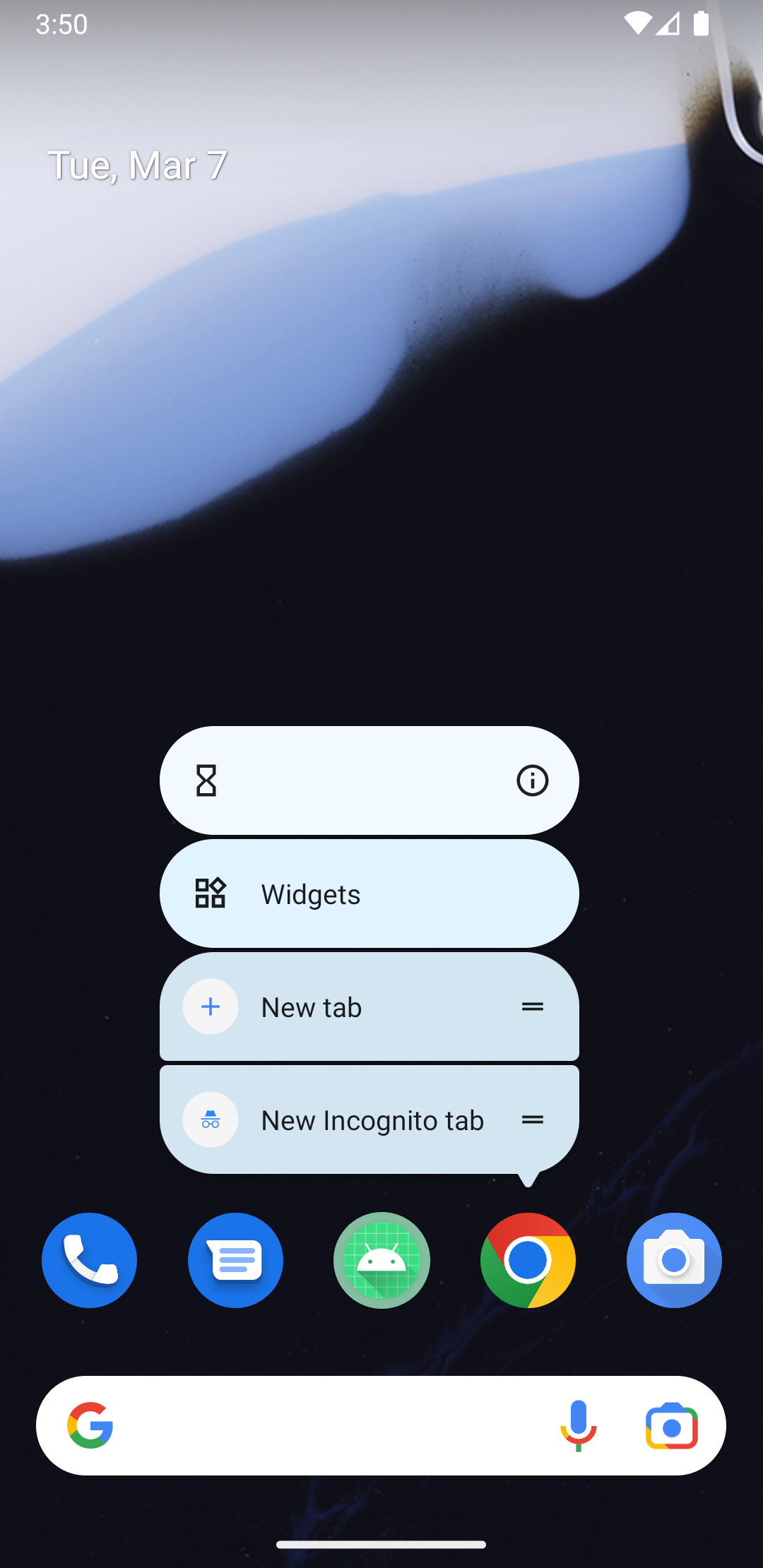ในฐานะนักพัฒนาแอป คุณสามารถกำหนดทางลัดเพื่อดำเนินการที่เฉพาะเจาะจง ในแอปของคุณได้ คุณสามารถแสดงทางลัดเหล่านี้ในตัวเรียกใช้หรือ ผู้ช่วยที่รองรับ เช่น Google Assistant และช่วยให้ผู้ใช้เริ่ม งานทั่วไปหรืองานที่แนะนำภายในแอปได้อย่างรวดเร็ว
เอกสารประกอบนี้แสดงวิธี สร้างและ จัดการทางลัดของแอป นอกจากนี้ คุณยังดูแนวทางปฏิบัติแนะนำบางส่วนเพื่อ ปรับปรุงทางลัดได้ด้วย
ประเภททางลัด

ทางลัดแต่ละรายการจะอ้างอิงIntent อย่างน้อย 1 รายการ ซึ่งแต่ละรายการจะเปิดใช้การดำเนินการที่เฉพาะเจาะจงในแอปเมื่อผู้ใช้เลือกทางลัด ประเภทของทางลัดที่คุณสร้างสำหรับแอปจะขึ้นอยู่กับกรณีการใช้งานของแอป ตัวอย่างการดำเนินการที่คุณแสดงเป็นทางลัดได้มีดังนี้
- การเขียนอีเมลใหม่ในแอปอีเมล
- นำทางผู้ใช้ไปยังสถานที่ที่เฉพาะเจาะจงในแอปการแมป
- การส่งข้อความไปยังรายชื่อติดต่อของผู้ใช้ในแอปการสื่อสาร
- เล่นรายการทีวีตอนถัดไปในแอปสื่อ
- กำลังโหลดจุดบันทึกล่าสุดในแอปเกม
- อนุญาตให้ผู้ใช้สั่งเครื่องดื่มในแอปจัดส่งโดยใช้คำสั่งที่พูด
คุณเผยแพร่ทางลัดประเภทต่อไปนี้สำหรับแอปได้
- ทางลัดแบบคงที่จะกำหนดไว้ในไฟล์ทรัพยากรที่แพ็กเกจเป็น APK หรือ App Bundle
- แอปของคุณจะพุช อัปเดต และนำทางลัดแบบไดนามิกออกได้ เฉพาะในเวลาที่รันเท่านั้น
- ทางลัดที่ปักหมุดจะเพิ่มลงใน Launcher ที่รองรับได้ในขณะรันไทม์ หาก ผู้ใช้ให้สิทธิ์
แสดงทางลัดในผู้ช่วยโดยใช้ความสามารถ
ความสามารถใน shortcuts.xml ช่วยให้คุณประกาศประเภท
ของการดำเนินการที่ผู้ใช้สามารถทำเพื่อเปิดแอปและไปยังการทำงาน
เฉพาะได้โดยตรง ตัวอย่างเช่น คุณสามารถให้ผู้ใช้ควบคุมแอปด้วยเสียงผ่าน Google Assistant ได้โดยการประกาศองค์ประกอบ capability ที่ขยายฟังก์ชันการทำงานในแอปไปยัง App Actions ของ Assistant ดูรายละเอียดเพิ่มเติมได้ในเอกสารประกอบเกี่ยวกับการเพิ่ม
ความสามารถ
ข้อจำกัดของทางลัด
Launcher ที่รองรับส่วนใหญ่จะแสดงทางลัดได้สูงสุด 4 รายการในครั้งเดียว ซึ่งรวมถึง ทั้งทางลัดแบบคงที่และแบบไดนามิก เมื่อพุชทางลัดแบบไดนามิกเพื่อแสดงบนแพลตฟอร์มของ Google เช่น Google Assistant ให้ใช้ไลบรารีการผสานรวมทางลัดของ Google เพื่อหลีกเลี่ยงการถูกจำกัดจำนวนทางลัด
หากเลือกไม่ใช้ไลบรารีการผสานรวมทางลัดของ Google แอปของคุณจะขึ้นอยู่กับขีดจำกัดของอุปกรณ์สำหรับจำนวนทางลัดที่รองรับในแต่ละครั้ง โดยทางลัดที่เผยแพร่ด้วยวิธีนี้จะปรากฏเฉพาะในตัวเรียกใช้ Android และ จะไม่ปรากฏในแพลตฟอร์มของ Google เช่น Assistant
ผู้ใช้สร้างทางลัดที่ปักหมุดไปยังแอปของคุณได้ไม่จำกัดจำนวน แอปของคุณไม่สามารถนำทางลัดที่ปักหมุดออกได้ แต่ปิดใช้ได้
หากต้องการเริ่มสร้างทางลัดสำหรับแอป โปรดดูเอกสารประกอบต่อไปนี้
ดูรายละเอียดเพิ่มเติมเกี่ยวกับการดำเนินการที่คุณทำได้กับทางลัดได้ที่
ShortcutManager
เอกสารอ้างอิง API

